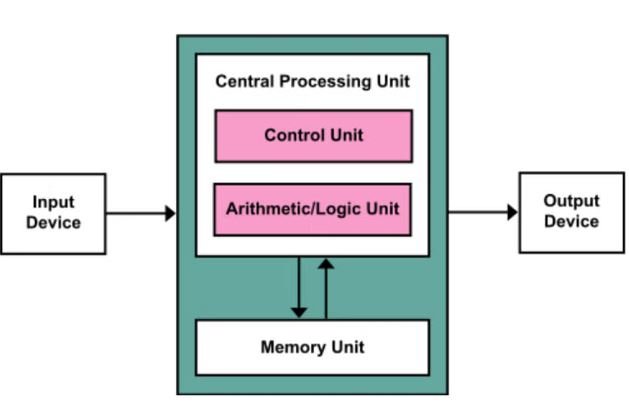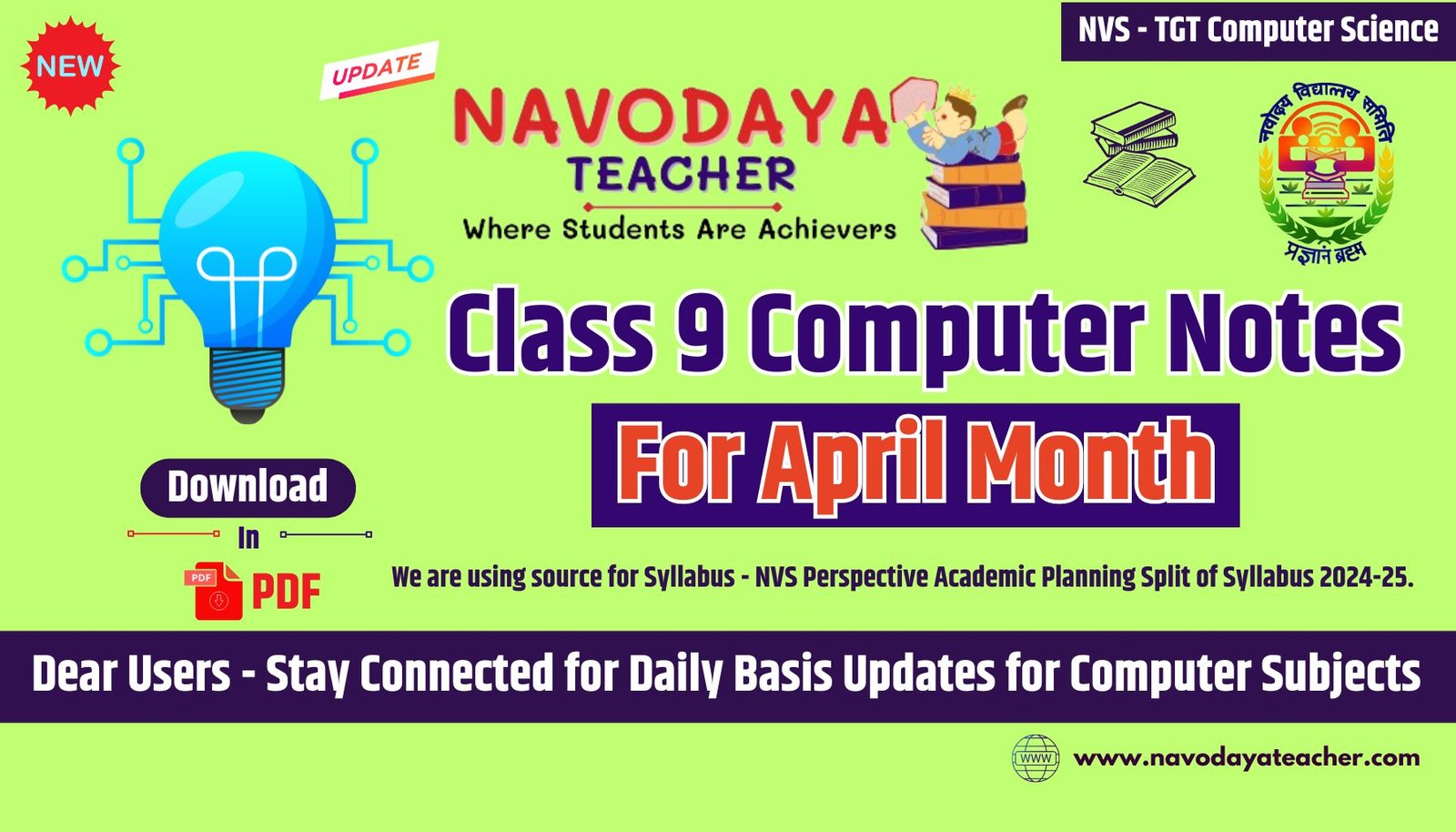In this article we provide information regarding latest Class 9 Computer Notes for April Month – Navodaya TGT Computer Science (CS) 2024-25.
Class 9 Computer Notes for April Month – Navodaya TGT CS
We are using source for Syllabus – Navodaya Vidyalaya Samiti Perspective Academic Planning Split of Syllabus 2024-25.
We are giving to the Point Notes for the Students.
Thanks Me Later
For the April Month Notes – Class 9 Computer Subject
Unites we covered in Notes
- Unit 1 : Basics of Information Technology
- Computer Systems : Characteristics of a computer, components of a computer system – CPU, Memory, Storage Devices and I/O Devices
- Memory : Primary (RAM and ROM) and secondary memory, Storage Devices : Hard disk, CD ROM, DVD, Pen/Flash Drive, Memory Stick
Unit 1 : Basics of Information Technology
What is IT ?
Information technology (IT) is the use of computer systems or devices to access information.
1. Computer System
Computer Basics
Definition : The computer is an electronic device. It is known as an electronic device because it runs through electricity. It takes input, processes it and gives desired results. The results of the computer system are also known as output.
The basic structure of the computer system is as follows –

Three major devices help to run the computer system smoothly.
Characteristics of a Computer system
Characteristics of a computer system let us know about its capabilities. The followings are the key characteristics of the computer system.
Speed
- The Computer is a much faster device
- Can solve very complex problems faster than a person.
- It gives results within a second
- Computer can solve multiple problems within very less time
Data Storage
- Can store a large amount of data for a long time period
- The data can be store in internal as well as external devices.
- The internal device of data storage is hard disk and external storage devices are Pen Drive, External Hard Disk, etc.
Accuracy
- Computers can generate reliable results with high computational speed.
- If the input is right then only the appropriate output will be generated.
- The computer never gives inaccurate results; if results are inaccurate it means inputted data erroneous.
Versatility
A computer is a versatile machine that can perform different types of jobs with same accuracy rate.
Diligence
- Computers never get tired.
- As humans get tiers when he works regularly but the computer can perform tasks over and over again, with the same outcome, and it does so without tiring.
No IQ
It performs a task that is exactly as directed by the user because it does not have its intelligence.
Reliable
Consistency refers that a computer is a reliable machine, as it always gives consistent results.
2. Memory
- Memory is a storage device of a computer system.
- This device is used to store data/information
- As per user’s need and the advancements in the computer industry, the manufacture’s developed advanced memory devices which can execute data speedily and can store large size data.
- In computer, the nature of data storage is into two forms i.e. temporary and permanently.
- Temporary storage is needed mostly at execution time.
- While the permanent store is needed after the execution of the programs when the user wants to save results permanently for future reference.
Input Device
- The computer takes input through input devices.
- It accepts data and instruction from the outside worlds.
- It converts these data and instruction into computer understandable from binary form.
- It supplied the converted data and instruction to the computer system for further processing.
- The most popular input devices are mouse, keyboard, joystick, microphone, camera, etc.
Processing Device
- CPU (Central Processing Unit) is a processing device.
- CPU is the brain or the heart of a computer. It is also known as processor and consist of three units namely –
- Control Unit (CU)
- Arithmetic Logic Unit (ALU)
- Main Memory Unit
- Microprocessor fixed inside it which processes data inputted by users input devices.
Output Device
- These are the devices that show processed results or messages to the user.
- The most popular output devices are Monitor and Printer.
- The monitor shows computer instructions and output in the form of soft contents.
- While the printer prints the desired results on paper.
- If the user wants to keep records then they prints it otherwise saves computerized contents in computer memory and uses these contents whenever they require .
1. Memory Unit
- Memory is also known as the storage medium of the computer system. This is a storage device that can store data/information. Memory is primarily categorized into two parts:
- Primary Memory :
- This is also known as the main memory or temporary memory or volatile memory. This memory device stores data for a temporary period. Programs or Instructions execute in Primary Memory.
- Primary memory further categorized into two parts –
- RAM (Random Access Memory)
- ROM (Read Only Memory)
- Secondary Memory :
- Secondary memory is a memory that can store a large amount of data in it. Once, data is saved into secondary cannot delete until and unless the user’s permission. It is also known as a permanent memory.
- Primary Memory :
2. ALU
- ALU stands for the Arithmetic and Logical Unit
- This is an important element of the computer system which is used to perform arithmetic and logical operations.
- ALU is a part of a computer processor.
3. Control Unit
- Control Unit controls all the devices connected to the computer system so that interrupt or unavoidable circumstances between device communications cannot happen.
- CU not only controls device communication but also program executions.
- CU mainly communicates between processor, memory and computer peripherals(input/output devices)
4. Storage Unit
Storage devices are the computer hardware used to remember/store data.
The different storage devices are :
- Hard Drive – An Internal Hard Drive is the main storage device in a computer. An external hard drive is also known as removable hard drive. It is used to store portable data and backups.
- CD ROM Disc – An optical storage device that is read – only or cannot be modified or deleted.
- DVD-R, DVD+R,DVD-RW and DVD+RW disc – DVD-R and DVD+R are recordable discs that can be written to once, while DVD-RW and DVD+RW are rewriteable discs that can be written to multiple times. The difference between the + and – is the formatting and compatibility.
- USB Flash Drive, Jump Drive or Thumb Drive – A small, portable storage device connected through the USB Port.
- Memory Stick – A memory card that is removable.
Thanks to Beloved Readers.











